Industry News, trenchless projects
Tough TBM and Team overcome the odds with Atlanta breakthrough
 On October 4, 2018, onlookers watched as a 3.8 m (12.5 ft) diameter Robbins Main Beam TBM completed its epic journey. The TBM, christened “Driller Mike”, after local rapper and activist “Killer Mike”, overcame extremely hard rock conditions along a curving 8.0 km (5.0 mi) tunnel to bolster the city of Atlanta, Georgia, USA’s water supply.
On October 4, 2018, onlookers watched as a 3.8 m (12.5 ft) diameter Robbins Main Beam TBM completed its epic journey. The TBM, christened “Driller Mike”, after local rapper and activist “Killer Mike”, overcame extremely hard rock conditions along a curving 8.0 km (5.0 mi) tunnel to bolster the city of Atlanta, Georgia, USA’s water supply.
The new tunnel brings the Atlanta Water Supply Program one step closer to increasing the city’s water capacity to between 30 and 90 days depending on daily usage. “Our schedule for the project was very aggressive but the project team stayed together to overcome issues related to the mining of the tunnel,” said Bob Huie, Project Director for the PC Russell JV, the Construction Manager at Risk (CMAR) for the project.
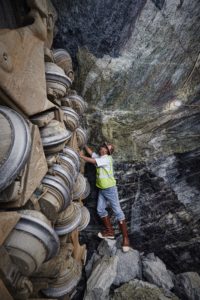 The unique structure of the project team is credited with the overall project success despite challenges. “I’m proud of our team. They had obstacles and challenges and challenging ground, but they stuck together and didn’t give up, and they were successful. There was great leadership and supervision all around,” said Larry Weslowski, Tunnel Superintendent for the PC Russell JV.
The unique structure of the project team is credited with the overall project success despite challenges. “I’m proud of our team. They had obstacles and challenges and challenging ground, but they stuck together and didn’t give up, and they were successful. There was great leadership and supervision all around,” said Larry Weslowski, Tunnel Superintendent for the PC Russell JV.
The project is only the third such large construction project in the U.S. to use the CMAR structure. The PC Construction/HJ Russell JV was selected as the CMAR for the project, who then purchased the Robbins Main Beam TBM for the tunnel. The designer for the construction works including tunnel and shafts, JP2—consisting of Stantec, PRAD Group, Inc., and River 2 Tap—specified the hard rock TBM. Operation and assembly of the TBM was then sub-contracted to the Atkinson/Technique JV.
 The robust TBM was assembled using Onsite First Time Assembly (OFTA) at the massive Bellwood Quarry site with help from Robbins personnel. “The guys built everything per the specs to help with scheduling. It was a challenge but there was no negativity during the process,” said Weslowski. Despite summer temperatures hitting 43 degrees Celsius (110 degrees Fahrenheit) and 100 percent humidity, the TBM was ready to launch by October 2016.
The robust TBM was assembled using Onsite First Time Assembly (OFTA) at the massive Bellwood Quarry site with help from Robbins personnel. “The guys built everything per the specs to help with scheduling. It was a challenge but there was no negativity during the process,” said Weslowski. Despite summer temperatures hitting 43 degrees Celsius (110 degrees Fahrenheit) and 100 percent humidity, the TBM was ready to launch by October 2016.
Hard granitic rock challenged the 19-inch disc cutters from the outset. “There was ground so hard that it would take eight hours to go 1.5 m (5 ft). It was between 117 and 310 MPa (17,000 and 45,000 psi) UCS. The beginning of the job was tough,” said Weslowski, but he added that once the learning curve had been overcome “they started breaking project records left and right towards the end. We got a best day of 38.4 m (126 ft). Rates just kept increasing.”
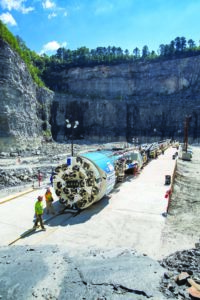 Other challenges included groundwater encountered during tunneling. “We did encounter groundwater contamination that required remediation. This remediation work was completed successfully,” said Huie.
Other challenges included groundwater encountered during tunneling. “We did encounter groundwater contamination that required remediation. This remediation work was completed successfully,” said Huie.
With tunneling complete, the USD $300 million project for the City of Atlanta’s Department of Watershed Management is on track to meet its scheduled overall completion date of September 2019. The project will turn the inactive Bellwood quarry into a 9.1 billion liter (2.4 billion gallon) raw water storage facility connecting with the Chattahoochee River and various water treatment facilities.
Image 1: The PC Russell JV and Atkinson/Technique JV celebrate the breakthrough of the Robbins TBM on October 4, 2018 in Atlanta, Georgia, USA.
Image 2: The Robbins TBM and 19-inch cutters overcame exceedingly hard granitic rock at strengths up to 310 MPa (45,000 psi) UCS.
Image 3: Crews are proud of the coordination required to overcome a host of challenges, including tight tunnel curves and contaminated groundwater that required remediation.
Image 4: The robust TBM was assembled using Onsite First Time Assembly (OFTA) at the massive Bellwood Quarry site with help from Robbins personnel.
Industry News
 Rock Underground, located in the city of Greenfield, MN, is an expert in utility work and exclusively uses Vac-Tron units for locating underground utilities. “All we run is Vac-Tron, every crew we have runs a Vac-Tron model,” says Adam Rock, Founder of Rock Underground.
Rock Underground, located in the city of Greenfield, MN, is an expert in utility work and exclusively uses Vac-Tron units for locating underground utilities. “All we run is Vac-Tron, every crew we have runs a Vac-Tron model,” says Adam Rock, Founder of Rock Underground.
Project Descriptions
Potholing and locating underground utilities safely and efficiently.
Solution
Vac-Tron’s LP 873 SDT vacuum excavator. Vacuum excavation is the best method of identifying the location and accurate depth of a utility. “Being in the utility business we have to pothole utilities all the time; whether it’s a gas line, fiber optic, telephone cable, we use a Vac-Tron vacuum excavator 90% of the time to verify utilities so we don’t hit them,” says Rock.
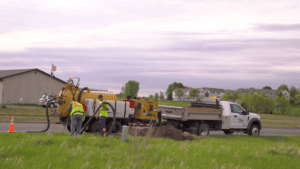 The LP SDT series is the top selling High CFM Diesel trailer for Vac-Tron. It includes a Yanmar 49 hp Tier 4 final diesel engine with 1,000 CFM vacuum blower for both wet/dry applications.
The LP SDT series is the top selling High CFM Diesel trailer for Vac-Tron. It includes a Yanmar 49 hp Tier 4 final diesel engine with 1,000 CFM vacuum blower for both wet/dry applications.
Rock said “I chose high CFM obviously for the capability of what it can do sucking up the dirt. Everybody can buy the water pressure, everybody can buy the blower, but the technology of the unit itself, the trailer setup, and the power it has, is why we choose Vac-Tron.”
Results
- Accurately and safely verifying underground utilities
- Productivity increase
- Efficiency with time and money
- Being able to clean other equipment
- Many other uses and applications…
Vac-Tron’s LP (Low Profile) series is the premiere line of industrial vacuums and vacuum excavation equipment. Available with gas or diesel engines and high or low CFM. The LP Series starts with 300-gallon debris tanks and goes up to 1,200-gallon debris tanks.
Vac-Tron units come standard with the patented (Big Red) CVS filtration system that is unmatched by competitors, a reverse pressure system, and a heavy-duty I-beam trailer with Dexter torsion axles. The low-profile trailers are hand built at the factory in Florida from the ground up keeping the components of the unit easily accessible while making the unit safe to tow and a much smoother ride. It also provides the best ground clearance in the industry for right of way maneuverability.
For more info or for a FREE Demo visit www.vactron.com or call 1-888-VAC-TRON.
Industry News, trenchless projects
Project profile submitted by Insta-Pipe – Trenchless Pipe Repair using the Pull in Place pressure liner “PRIMUS Line”.
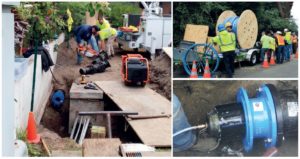 Client: Southwest Suburban Sewer District
Client: Southwest Suburban Sewer District
Engineering and Installation Partner: Insta Pipe – Trenchless Pipe Repair, Olympia, WA
Year of Construction: May 2016
Type of Project: Rehabilitation of an 8 inch sewer force main with 60psi rating and vertical bends in host pipe alignment
Our services:
- Supply and delivery of the flexible low Pressure 8 inch Primus Liner (ANSI/NSF 61 approved)
- Delivery of the 8 inch Primus Line low pressure connectors (150 lbs)
 Task: After a recent emergency repair the Southwest Suburban Sewer District decided to upgrade the existing primarily ductile iron line. The project was located at Shorewood Dr. SW corner SW 125th and runs down the hill to pump station 7, which is located between two houses next to the bay. The section to be rehabilitated was 262 linear feet long and encloses multiple vertical bends of up to 22 degrees with a maximum operating pressure of 60 psi. Since the pipe runs on a steep hill and through people’s gardens in a residential area, a traditional open trench solution was not reasonable. Therefore, the sewer district had to choose between two trenchless technologies: Primus Line® and CIPP.
Task: After a recent emergency repair the Southwest Suburban Sewer District decided to upgrade the existing primarily ductile iron line. The project was located at Shorewood Dr. SW corner SW 125th and runs down the hill to pump station 7, which is located between two houses next to the bay. The section to be rehabilitated was 262 linear feet long and encloses multiple vertical bends of up to 22 degrees with a maximum operating pressure of 60 psi. Since the pipe runs on a steep hill and through people’s gardens in a residential area, a traditional open trench solution was not reasonable. Therefore, the sewer district had to choose between two trenchless technologies: Primus Line® and CIPP.
Rehabilitation System: After an open communication with Primus Line and Insta-Pipe, the Southwest Suburban Sewer District decided to use the Primus Line® system, a flexible relining solution for the trenchless renovation of pressure pipes. The system convinces with its ability to negotiate bends, the minimally invasive construction footprint and the short installation time. In this particular case, the budget was reduced by over 50% compared to the lowest offers with CIPP and was even cheaper than the Engineer’s Estimate.
Project Description: The decision was to install a Primus Line® DN 200 ND with a nominal diameter of 8 inch and a nominal design pressure of 290 psi. Since the technology works with an annular space to achieve long insertion lengths and negotiate bends, the liner provides an actual outer diameter of 7.165 inch and inner diameter of 6.693 inch. According to the calculation of the technical department of Primus Line, the pressure rating of the system through the bends is 217 psi and thus capable of accommodating the maximal operating pressure of 60 psi along the entire pipe route. To complete the system, the low pressure connectors with an operating pressure of 150 psi were used to guarantee a durable and tensile strong connection.
In a first step, the two excavation pits for the installation of the Primus Line® system had to be created. After that the station was pumped down, the force main was dewatered and the pipe was cut for water jet cleaning and CCTV inspection. Due to the heavy incrustations in the host pipe this was performed in a 6 hour window on the first two days, because there was no bypass planned and so the pipe had to be spooled back together in the evening to empty the pump station. After one last cleaning and inspection on the third day, the pre-folded and coiled on a transport reel Kevlar® reinforced composite liner was inserted with speeds up to 15 ft. /min and inflated with 7 psi to bring it back into its round shape. Subsequently the low pressure termination fittings were installed, a pressure test with 60 psi was performed and successfully completed and the pump station was put back into service that evening. During the next morning the pits were closed and the project was successfully accomplished after a total construction time of 4 days and without shutting the pump station down for longer than a daytime window.
Insta-Pipe, Trenchless Pipe Repair
REPAIR SEWERS WITHOUT TRENCHING, WITH SEWER PIPE LINING
With over 25 years of experience, Insta-Pipe Trenchless Pipe Repair can repair sewer and storm lines and repair outside drain pipes with pipe lining services in WA, OR and surrounding areas. Don’t trench when you can take advantage of our pipe lining evaluation and services.
Phone: 360-943-5840 Toll Free: 866-463-9747
855 Trosper Rd SW, 108-204 Olympia, Washington 98512
www.insta-pipe.com
Raedlinger Primus Line, Inc.
112 South Tryon Street, Suite 1130
Charlotte, North Carolina 28284
info@primusline.com www.primusline.com
Industry News, trenchless projects
Hiroshima Heavyweight Launches on Expressway Line 5
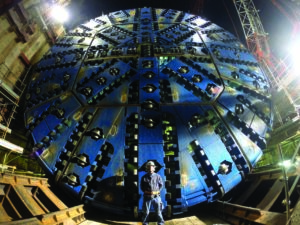 On September 18, 2018, a Robbins mega-sized slurry machine, measuring 13.7 m (44.8 ft) in diameter, made its first cut into hard rock. The epic launch at an urban jobsite was made possible by Onsite First Time Assembly (OFTA) of the TBM in Japan for the Hiroshima Expressway Line 5 project. The contractor, a joint venture of Obayashi-Taisei-Kosei, had a strict timeline of eight months to adhere to when it came to machine assembly. “This deadline was very important. After assembling the TBM, I think OFTA was appropriate for this project,” said Mr. Ryota Akai, Deputy Project Manager for the Obayashi JV.
On September 18, 2018, a Robbins mega-sized slurry machine, measuring 13.7 m (44.8 ft) in diameter, made its first cut into hard rock. The epic launch at an urban jobsite was made possible by Onsite First Time Assembly (OFTA) of the TBM in Japan for the Hiroshima Expressway Line 5 project. The contractor, a joint venture of Obayashi-Taisei-Kosei, had a strict timeline of eight months to adhere to when it came to machine assembly. “This deadline was very important. After assembling the TBM, I think OFTA was appropriate for this project,” said Mr. Ryota Akai, Deputy Project Manager for the Obayashi JV.
 Due to the project location there were also restrictions on delivering the TBM—in order to meet controlled transportation limits within the city, the TBM had to be divided into small transportable weights and sizes, then assembled in a small jobsite measuring just 30 m (100 ft) wide x 60 m (200 ft) long. The 2,400 metric ton (2,650 US ton) machine will bore 1.4 km (0.9 mi) of the 1.8 km (1.1 mi) long tunnel that, once completed, will significantly improve traffic conditions in Hiroshima.
Due to the project location there were also restrictions on delivering the TBM—in order to meet controlled transportation limits within the city, the TBM had to be divided into small transportable weights and sizes, then assembled in a small jobsite measuring just 30 m (100 ft) wide x 60 m (200 ft) long. The 2,400 metric ton (2,650 US ton) machine will bore 1.4 km (0.9 mi) of the 1.8 km (1.1 mi) long tunnel that, once completed, will significantly improve traffic conditions in Hiroshima.
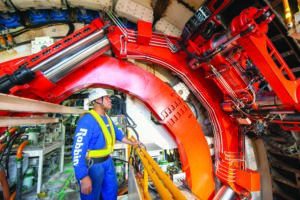 The massive machine is the country’s first foreign-made large diameter Slurry TBM to excavate hard rock in Japan. “There is a lot of hard rock in Hiroshima,” said Mr. Akai, “and Robbins has a lot of experience boring hard rock.” The machine is expected to encounter granite with rock strengths up to 130 MPa (19,000 psi) UCS. Those involved in the project are excited to see what effect this will have on how Slurry TBMs are used in the future. “The development of this TBM is a milestone,” said Mr. Kiyomi Sasaki, General Manager of Robbins Japan, “it will lead to new tunnel applications worldwide.”
The massive machine is the country’s first foreign-made large diameter Slurry TBM to excavate hard rock in Japan. “There is a lot of hard rock in Hiroshima,” said Mr. Akai, “and Robbins has a lot of experience boring hard rock.” The machine is expected to encounter granite with rock strengths up to 130 MPa (19,000 psi) UCS. Those involved in the project are excited to see what effect this will have on how Slurry TBMs are used in the future. “The development of this TBM is a milestone,” said Mr. Kiyomi Sasaki, General Manager of Robbins Japan, “it will lead to new tunnel applications worldwide.”
The design of the Slurry machine is robust in anticipation of potentially abrasive rock conditions and water pressures up to 13 bars. “The Robbins machine is very tough, for example the weight is very heavy. The cutterhead, both its material and structure, are very tough. It will not break in hard rock,” said Mr. Akai.
In preparation for the conditions, the machine was designed for 20-bar water pressure. The robust cutterhead was fitted with 20-inch and 17-inch diameter pressure compensating cutters, which utilize a patented design to effectively operate under high pressure. The joint venture intends to change the disc cutters an estimated 10 times during the bore as part of the machine’s maintenance.
Throughout the assembly and launch process the joint venture crew worked with Robbins Supervisors who assisted and provided guidance. “Robbins crews have a lot of experience; they help us every day despite the language barriers. I appreciate it,” said Mr. Akai.
The new Expressway Line 5 tunnel will directly connect Hiroshima’s urban area with a major national highway network and is expected to improve access to Hiroshima Airport. Tunnel completion is planned for 2020.
Image 1: Robbins crews assisted the contractor during Onsite First Time Assembly (OFTA) of the massive Slurry TBM in a jobsite measuring just 30 m (100 ft) wide x 60 m (200 ft) long.
Image 2: The 13.7 m (44.87 ft) diameter Robbins Slurry machine launched on September 18, 2018 in Hiroshima, Japan.
Image 3: Guerin Nolasco of Robbins Field Service looks on during testing of the segment erector inside a mega-sized slurry machine at the Hiroshima Expressway Line 5 project.
Industry News, trenchless products
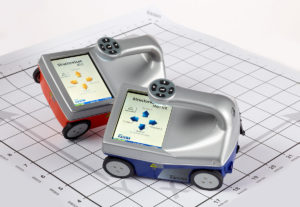 GSSI, the world’s leading manufacturer of ground penetrating radar (GPR) equipment, will be highlighting its StructureScan Mini XT and StructureScan Mini LT systems, and the StructureScan Palm XT antenna at The American Society for Nondestructive Testing Annual Conference, being held October 28-30, 2018, at the George R. Brown Convention Center in Houston, Texas. GSSI will be
GSSI, the world’s leading manufacturer of ground penetrating radar (GPR) equipment, will be highlighting its StructureScan Mini XT and StructureScan Mini LT systems, and the StructureScan Palm XT antenna at The American Society for Nondestructive Testing Annual Conference, being held October 28-30, 2018, at the George R. Brown Convention Center in Houston, Texas. GSSI will be 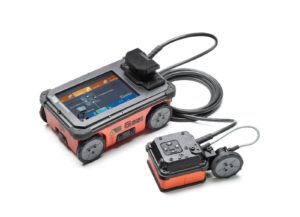 exhibiting its products at booth #941.
exhibiting its products at booth #941.
StructureScan Mini XT – the newest generation of GSSI’s popular all-in-one concrete inspection GPR system is ideal for locating rebar, conduits, post-tension cables, and voids. The Mini XT can help identify structural elements, including pan decking and concrete cover, and can also provide real time determination of concrete slab thickness. StructureScan Mini XT is the perfect blend of price and performance and is backed by a two-year warranty. It features an intuitive touchscreen interface and six-button control options.
Visitors to the booth can also see a demonstration of the newest accessory for the StructureScan Mini XT. The Palm XT Antenna is a miniaturized GPR antenna that is designed to greatly enhance the capabilities of the StructureScan Mini XT. The handheld Palm XT antenna turns a basic Mini XT into an advanced system by giving users unparalleled access in tightly spaced areas and enabling overhead scanning. Designed to withstand challenging construction sites, the Palm XT is an excellent choice for contractors and engineers alike who need to perform nondestructive testing of concrete structures.
In addition to the Mini XT and the Palm XT accessory, GSSI will be displaying the StructureScan Mini LT. This unit is an integrated all-in-one concrete inspection tool that can help identify structural elements like concrete cover and provides real-time concrete slab thickness measurements. The Mini LT is an all-in-one GPR system that is IP 65-rated to withstand a jobsite’s toughest conditions and features an easy-to-use interface. The StructureScan Mini LT is the perfect entry-level concrete inspection system.
About GSSI
Geophysical Survey Systems, Inc. is the world leader in the development, manufacture, and sale of ground penetrating radar (GPR) equipment, primarily for the concrete inspection, utility mapping and locating, road and bridge deck evaluation, geophysics, and archaeology markets. Our equipment is used all over the world to explore the subsurface of the earth and to inspect infrastructure systems non-destructively. GSSI created the first commercial GPR system nearly 50 years ago and continues to provide the widest range and highest quality GPR equipment available today.
Industry News, trenchless products
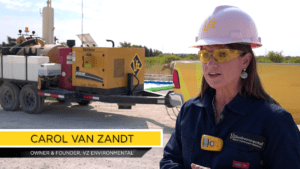 VZ Environmental is an innovative leader in secondary drip and spill containment for the oil and gas industry. Carol Van Zandt, owner of VZ Environmental, was challenged by a customer to find a simple method to contain liquid spills in the oil and gas industry. Carol partnered with an equipment supplier to design a drive-over foam bermed containment membrane (VMatz™) to capture and dispose of drips and spills on oil and gas sites. They then utilize a Vac-Tron vacuum excavator to clean up the spill from the containment membrane for proper disposal.
VZ Environmental is an innovative leader in secondary drip and spill containment for the oil and gas industry. Carol Van Zandt, owner of VZ Environmental, was challenged by a customer to find a simple method to contain liquid spills in the oil and gas industry. Carol partnered with an equipment supplier to design a drive-over foam bermed containment membrane (VMatz™) to capture and dispose of drips and spills on oil and gas sites. They then utilize a Vac-Tron vacuum excavator to clean up the spill from the containment membrane for proper disposal.
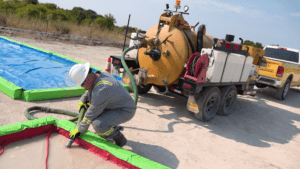 Today, VZ Environmental provides equipment nationwide, servicing areas in five states and have plans for further domestic and international expansion to continue to help oil and gas operators minimize their impact on the environment.
Today, VZ Environmental provides equipment nationwide, servicing areas in five states and have plans for further domestic and international expansion to continue to help oil and gas operators minimize their impact on the environment.
Project Descriptions
VMatz are spill containments that VZ provides for oil and gas operators to minimize their impact on the environment. “Our customers use the VMatz to catch drips and spills while on location and then we come in to cleanup,” says Carol. VZ wanted to provide their own vacuum service to their customers as part of the cleanup process, so that the customer didn’t have to waste time and money calling out for a vacuum truck company and VZ environmental didn’t have to sit on location and wait for the vacuum truck to arrive before they could cleanup.
Solution
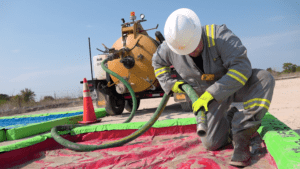 Vac-Tron vacuum trailers for vacuum service and cleanup. “The Vac-Tron trailer helps us clean up our VMAtz by removing the fluid from our containments more efficiently and a lot faster. We are not sitting on location waiting on vacuum trucks to arrive. Prior to having Vac-Tron vacuum trailers in our fleet of equipment, we did not offer any type of vacuum service. Our customers had to order a vacuum truck to come help us remove the fluid when we were cleaning our Vmatz. Our Vac-Tron units come with 500-gallon debris tanks and 1,000 cfm which helps us pick up the rocks and sludge that our customers leave in our containments. This is a perfect size because its small and they can park it off to the side, then call upon it as needed,” says Carol.
Vac-Tron vacuum trailers for vacuum service and cleanup. “The Vac-Tron trailer helps us clean up our VMAtz by removing the fluid from our containments more efficiently and a lot faster. We are not sitting on location waiting on vacuum trucks to arrive. Prior to having Vac-Tron vacuum trailers in our fleet of equipment, we did not offer any type of vacuum service. Our customers had to order a vacuum truck to come help us remove the fluid when we were cleaning our Vmatz. Our Vac-Tron units come with 500-gallon debris tanks and 1,000 cfm which helps us pick up the rocks and sludge that our customers leave in our containments. This is a perfect size because its small and they can park it off to the side, then call upon it as needed,” says Carol.
Results
- Saves customers time and money
- Eliminates down time
- Keeps environment safer
“With a Vac-Tron trailer, we can save our customers money through minimizing the number of trips that they have to call out a vacuum truck. When shopping for vacuum trailers, Vac-Tron is by far the best! Our machines, every time you turn them on, they are rip roaring to go. Our employees don’t have time to go through and try to figure out things, they want to flip it on and use it immediately and they want it to work. Vac-Tron does that for us every time,” says Carol.
Check out the full video interview with VZ Environmental here. For more information on Vac-Tron Equipment and its full fleet of vacuum excavators, please visit them online at www.vactron.com or call 1-352-728-2222.
Industry News, trenchless people
Missen brings over 25 years experience to the position
 GREENVILLE, S.C. — September 24, 2018 — McLaughlin Group, Inc. continues to grow its expertise in the underground construction industry with the addition of Neville Missen, an industry veteran who has played in integral role in developing microtunneling equipment and steerable rock systems. In his new role as applications engineer for McLaughlin auger boring equipment, On Target steering systems and steerable rock systems, Missen will work with contractors, dealers and the McLaughlin team to develop innovative equipment solutions that will continue to advance the industry.
GREENVILLE, S.C. — September 24, 2018 — McLaughlin Group, Inc. continues to grow its expertise in the underground construction industry with the addition of Neville Missen, an industry veteran who has played in integral role in developing microtunneling equipment and steerable rock systems. In his new role as applications engineer for McLaughlin auger boring equipment, On Target steering systems and steerable rock systems, Missen will work with contractors, dealers and the McLaughlin team to develop innovative equipment solutions that will continue to advance the industry.
Missen, a native of Australia, has owned and operated Boretec Microtunneling Pty, Ltd, managed Bullseye Microtunneling, and served as an equipment sales representative for Vermeer Australia.
“Neville has been a trusted partner of ours for many years,” explained Dave Gasmovic, business development manager at McLaughlin. “We worked with him when he was a contractor and he always provided helpful information for developing new products. From the work Neville has done testing machinery to the role he’s served in designing new equipment, he has helped fuel the growth of auger boring and microtunneling. We are excited to have him working for McLaughlin.”
For more information about McLaughlin products and services, visit www.mclaughlinunderground.com or email McLaughlin at mmole@mightymole.com.
About McLaughlin
McLaughlin, a Vermeer Company, has been actively involved in the drilling tool industry for more than 95 years. McLaughlin has a reputation for designing and building dependable trenchless construction equipment. McLaughlin takes pride in providing solutions for OEMs and the underground industry.
McLaughlin Group, Inc. reserves the right to make changes in engineering, design and specifications; add improvements; or discontinue manufacturing at any time without notice or obligation. McLaughlin and the McLaughlin logo are trademarks of McLaughlin Group, Inc. in the U.S. and/or other countries.
© 2018 McLaughlin Group, Inc. All Rights Reserved.
Industry News, trenchless people
 PHILADELPHIA, PA ‐ Pipe Lining Supply is pleased to announce the appointment of Augustus “Gus” Bozzano, II to the position of Technical Representative serving the north eastern USA.
PHILADELPHIA, PA ‐ Pipe Lining Supply is pleased to announce the appointment of Augustus “Gus” Bozzano, II to the position of Technical Representative serving the north eastern USA.
Gus brings many years of plumbing and drain cleaning experience to the new position.
Gus will support Pipe Lining Supply’s customer base with training, advice and sales for CIPP lateral lining and AIPPR pipe coating projects for drain, waste and vent in the Philadelphia and surrounding areas.
Pipe Lining Supply is a leader in the manufacturing and distribution of materials and equipment used in the lateral sewer lining and DWV rehabilitation business. The company was formed to support customers who need training and support as well as the equipment and materials to rehabilitate aging sewer laterals and pipe to restore your pipes to LIKE new condition, extending pipe life 50+ years!
Their goal is to serve the industry with a complete warehouse stocked with the best products at the lowest delivered cost on a timely basis. Visit their website for more information.
Industry News, trenchless products
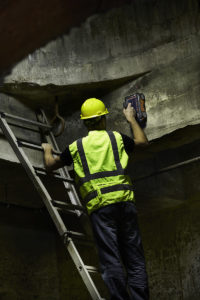 GSSI, the world’s leading manufacturer of ground penetrating radar (GPR) equipment, announces the addition of a new drill hole feature to the StructureScan™ Mini XT – the newest generation of GSSI’s popular all-in-one concrete inspection GPR system. The drill hole feature is a 3D data processing detection algorithm. The algorithm evaluates a user chosen cylindrical area that represents a potential or planned coring location. Scanning for all potential targets within the cylindrical area, the drill hole feature looks for targets that may interfere with a proposed coring location.
GSSI, the world’s leading manufacturer of ground penetrating radar (GPR) equipment, announces the addition of a new drill hole feature to the StructureScan™ Mini XT – the newest generation of GSSI’s popular all-in-one concrete inspection GPR system. The drill hole feature is a 3D data processing detection algorithm. The algorithm evaluates a user chosen cylindrical area that represents a potential or planned coring location. Scanning for all potential targets within the cylindrical area, the drill hole feature looks for targets that may interfere with a proposed coring location.
Available only within the StructureScan Mini XT user interface, the drill hole indicator is designed for concrete coring applications. In complicated slab situations, the drill hole feature can help users determine the safest location for coring concrete. However, this feature is not a substitute for careful analysis by a trained operator, and GSSI does not recommend that the user depend solely on this algorithm for drill hole interpretation.
Operators should receive special training prior to using this new aid. During training, customers can select areas that they believe are safe for coring while the feature is turned off, and turn the feature on to double check and confirm the initial mark outs.
The new drill hole feature will work with all StructureScan Mini XT’s already in the field, and only requires a software update of the system. New units will come with this user interface pre-installed.
About GSSI
Geophysical Survey Systems, Inc. is the world leader in the development, manufacture, and sale of ground penetrating radar (GPR) equipment, primarily for the concrete inspection, utility mapping and locating, road and bridge deck evaluation, geophysics, and archaeology markets. Our equipment is used all over the world to explore the subsurface of the earth and to inspect infrastructure systems non-destructively. GSSI created the first commercial GPR system nearly 50 years ago and continues to provide the widest range and highest quality GPR equipment available today.
Industry News, trenchless products, trenchless projects
Massive XRE Machine breaks through at Akron OCIT
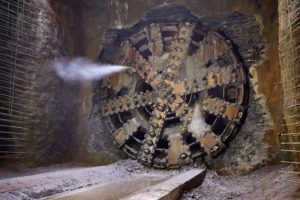 On August 29, 2018, a 9.26 m (30.4 ft) diameter Robbins Crossover (XRE) TBM crossed the finish line at the Akron Ohio Canal Interceptor Tunnel (OCIT). A press day followed on September 5, where companies and members of the media were invited to view the giant machine. The machine—dubbed “Rosie” in honor of Rosie the Riveter, an icon representing American women who worked in factories and shipyards during World War II—overcame tough ground conditions during the bore.
On August 29, 2018, a 9.26 m (30.4 ft) diameter Robbins Crossover (XRE) TBM crossed the finish line at the Akron Ohio Canal Interceptor Tunnel (OCIT). A press day followed on September 5, where companies and members of the media were invited to view the giant machine. The machine—dubbed “Rosie” in honor of Rosie the Riveter, an icon representing American women who worked in factories and shipyards during World War II—overcame tough ground conditions during the bore.
 “One of the most challenging aspects of this job was that we launched right into the most difficult part. We had 60 m (200 ft) of soft ground, a very short reach, and then from there we went right into a mixed face for 180 m (600 ft),” said David Chastka, Project Manager for Kenny Construction, a joint venture contractor on the project with Obayashi. “It took everybody we had in the industry, everybody from Robbins, to fight through that first 240 m (800 ft).”
“One of the most challenging aspects of this job was that we launched right into the most difficult part. We had 60 m (200 ft) of soft ground, a very short reach, and then from there we went right into a mixed face for 180 m (600 ft),” said David Chastka, Project Manager for Kenny Construction, a joint venture contractor on the project with Obayashi. “It took everybody we had in the industry, everybody from Robbins, to fight through that first 240 m (800 ft).”
 The TBM was designed for the project’s geology, which transitioned from soil to partial face shale to full face shale rock. The Crossover XRE included features of both EPB and Hard Rock Single Shield TBM types, with a versatile cutterhead that could be configured for hard rock or soft ground conditions. While in soft ground and mixed face conditions the machine operated in closed mode, but once it hit solid rock crews switched excavation to open mode. “The machine had the power to get to the other side and made advance rates we never thought we were going to get. It was very successful in hard rock,” said Chastka. Advance rates once in full-face shale rock reached a high of 34 m (111 ft) in one day (two 10-hour shifts). Muck removal was achieved using a Robbins continuous conveyor, and conveyor availability remained high throughout the project.
The TBM was designed for the project’s geology, which transitioned from soil to partial face shale to full face shale rock. The Crossover XRE included features of both EPB and Hard Rock Single Shield TBM types, with a versatile cutterhead that could be configured for hard rock or soft ground conditions. While in soft ground and mixed face conditions the machine operated in closed mode, but once it hit solid rock crews switched excavation to open mode. “The machine had the power to get to the other side and made advance rates we never thought we were going to get. It was very successful in hard rock,” said Chastka. Advance rates once in full-face shale rock reached a high of 34 m (111 ft) in one day (two 10-hour shifts). Muck removal was achieved using a Robbins continuous conveyor, and conveyor availability remained high throughout the project.
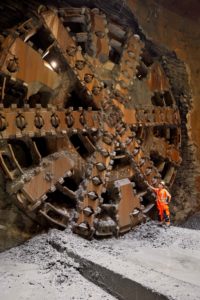 “I am most proud of the team that I have had the pleasure of being a part of,” said Don Smida, Robbins Field Service Technician. The overall scope of a project of this scale is immense, and the amount of daily cooperation & hard work that has been asked of The Robbins Company, the local unions, city staff, and Kenny-Obayashi is extremely important in reaching our common goals. I think we should all be proud of our teamwork going forward from a successful completion of the tunnel and into a successful disassembly of Rosie.”
“I am most proud of the team that I have had the pleasure of being a part of,” said Don Smida, Robbins Field Service Technician. The overall scope of a project of this scale is immense, and the amount of daily cooperation & hard work that has been asked of The Robbins Company, the local unions, city staff, and Kenny-Obayashi is extremely important in reaching our common goals. I think we should all be proud of our teamwork going forward from a successful completion of the tunnel and into a successful disassembly of Rosie.”
Now that tunneling is complete, the machine will be disassembled and removed from its retrieval shaft this autumn. “The Ohio Canal Interceptor Tunnel is the largest public improvement project in our City’s history and a significant investment in our environment and infrastructure that will benefit Akron residents and businesses for generations to come,” said the City of Akron’s Mayor Daniel Horrigan. “Projects of this kind are inherently dangerous, and I am incredibly proud that the tunneling portion was completed without any major injuries, thanks to a dedicated team of professionals. And although Robbins is an international company with worldwide impact, we were pleased to be able to work with a local Northeast Ohio firm on this significant project.”
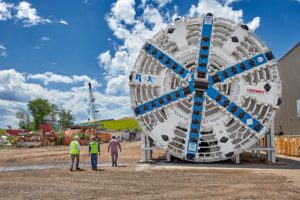 The OCIT Project for the City of Akron, Ohio, USA consists of the construction of a conveyance and storage tunnel system to control Combined Sewer Overflows (CSOs) for several regulators in the downtown Akron area. The EPA-mandated project includes the 1.89 km (1.17 mi) conveyance and storage tunnel, as well as drop shafts, diversion structures, consolidation sewers, and related structures.
The OCIT Project for the City of Akron, Ohio, USA consists of the construction of a conveyance and storage tunnel system to control Combined Sewer Overflows (CSOs) for several regulators in the downtown Akron area. The EPA-mandated project includes the 1.89 km (1.17 mi) conveyance and storage tunnel, as well as drop shafts, diversion structures, consolidation sewers, and related structures.
Image 1: On August 29, 2018, a 9.26 m (30.4 ft) diameter Robbins Crossover TBM broke through at the Akron Ohio Canal Interceptor Tunnel (OCIT).
Image 2: Personnel inspect the Robbins Crossover XRE TBM “Rosie”, named for Rosie the Riveter, after the breakthrough.
Image 3: A crew member cleans the cutterhead of the Robbins Crossover TBM following its breakthrough on August 29, 2018.
Image 4: The Robbins Crossover XRE machine—the first such machine to operate in the U.S.—achieved advance rates of up to 34 m (111 ft) per day in two 10-hour shifts.
Image 5: The 9.26 m (30.4 ft) diameter Robbins Crossover TBM was designed and built in Robbins’ Solon, Ohio, USA facility.
 On October 4, 2018, onlookers watched as a 3.8 m (12.5 ft) diameter Robbins Main Beam TBM completed its epic journey. The TBM, christened “Driller Mike”, after local rapper and activist “Killer Mike”, overcame extremely hard rock conditions along a curving 8.0 km (5.0 mi) tunnel to bolster the city of Atlanta, Georgia, USA’s water supply.
On October 4, 2018, onlookers watched as a 3.8 m (12.5 ft) diameter Robbins Main Beam TBM completed its epic journey. The TBM, christened “Driller Mike”, after local rapper and activist “Killer Mike”, overcame extremely hard rock conditions along a curving 8.0 km (5.0 mi) tunnel to bolster the city of Atlanta, Georgia, USA’s water supply. The unique structure of the project team is credited with the overall project success despite challenges. “I’m proud of our team. They had obstacles and challenges and challenging ground, but they stuck together and didn’t give up, and they were successful. There was great leadership and supervision all around,” said Larry Weslowski, Tunnel Superintendent for the PC Russell JV.
The unique structure of the project team is credited with the overall project success despite challenges. “I’m proud of our team. They had obstacles and challenges and challenging ground, but they stuck together and didn’t give up, and they were successful. There was great leadership and supervision all around,” said Larry Weslowski, Tunnel Superintendent for the PC Russell JV. The robust TBM was assembled using Onsite First Time Assembly (OFTA) at the massive Bellwood Quarry site with help from Robbins personnel. “The guys built everything per the specs to help with scheduling. It was a challenge but there was no negativity during the process,” said Weslowski. Despite summer temperatures hitting 43 degrees Celsius (110 degrees Fahrenheit) and 100 percent humidity, the TBM was ready to launch by October 2016.
The robust TBM was assembled using Onsite First Time Assembly (OFTA) at the massive Bellwood Quarry site with help from Robbins personnel. “The guys built everything per the specs to help with scheduling. It was a challenge but there was no negativity during the process,” said Weslowski. Despite summer temperatures hitting 43 degrees Celsius (110 degrees Fahrenheit) and 100 percent humidity, the TBM was ready to launch by October 2016. Other challenges included groundwater encountered during tunneling. “We did encounter groundwater contamination that required remediation. This remediation work was completed successfully,” said Huie.
Other challenges included groundwater encountered during tunneling. “We did encounter groundwater contamination that required remediation. This remediation work was completed successfully,” said Huie.
 Rock Underground, located in the city of Greenfield, MN, is an expert in utility work and exclusively uses
Rock Underground, located in the city of Greenfield, MN, is an expert in utility work and exclusively uses  The LP SDT series is the top selling High CFM Diesel trailer for Vac-Tron. It includes a Yanmar 49 hp Tier 4 final diesel engine with 1,000 CFM vacuum blower for both wet/dry applications.
The LP SDT series is the top selling High CFM Diesel trailer for Vac-Tron. It includes a Yanmar 49 hp Tier 4 final diesel engine with 1,000 CFM vacuum blower for both wet/dry applications. Client: Southwest Suburban Sewer District
Client: Southwest Suburban Sewer District Task: After a recent emergency repair the Southwest Suburban Sewer District decided to upgrade the existing primarily ductile iron line. The project was located at Shorewood Dr. SW corner SW 125th and runs down the hill to pump station 7, which is located between two houses next to the bay. The section to be rehabilitated was 262 linear feet long and encloses multiple vertical bends of up to 22 degrees with a maximum operating pressure of 60 psi. Since the pipe runs on a steep hill and through people’s gardens in a residential area, a traditional open trench solution was not reasonable. Therefore, the sewer district had to choose between two trenchless technologies: Primus Line® and CIPP.
Task: After a recent emergency repair the Southwest Suburban Sewer District decided to upgrade the existing primarily ductile iron line. The project was located at Shorewood Dr. SW corner SW 125th and runs down the hill to pump station 7, which is located between two houses next to the bay. The section to be rehabilitated was 262 linear feet long and encloses multiple vertical bends of up to 22 degrees with a maximum operating pressure of 60 psi. Since the pipe runs on a steep hill and through people’s gardens in a residential area, a traditional open trench solution was not reasonable. Therefore, the sewer district had to choose between two trenchless technologies: Primus Line® and CIPP. On September 18, 2018, a Robbins mega-sized slurry machine, measuring 13.7 m (44.8 ft) in diameter, made its first cut into hard rock. The epic launch at an urban jobsite was made possible by Onsite First Time Assembly (OFTA) of the TBM in Japan for the Hiroshima Expressway Line 5 project. The contractor, a joint venture of Obayashi-Taisei-Kosei, had a strict timeline of eight months to adhere to when it came to machine assembly. “This deadline was very important. After assembling the TBM, I think OFTA was appropriate for this project,” said Mr. Ryota Akai, Deputy Project Manager for the Obayashi JV.
On September 18, 2018, a Robbins mega-sized slurry machine, measuring 13.7 m (44.8 ft) in diameter, made its first cut into hard rock. The epic launch at an urban jobsite was made possible by Onsite First Time Assembly (OFTA) of the TBM in Japan for the Hiroshima Expressway Line 5 project. The contractor, a joint venture of Obayashi-Taisei-Kosei, had a strict timeline of eight months to adhere to when it came to machine assembly. “This deadline was very important. After assembling the TBM, I think OFTA was appropriate for this project,” said Mr. Ryota Akai, Deputy Project Manager for the Obayashi JV. Due to the project location there were also restrictions on delivering the TBM—in order to meet controlled transportation limits within the city, the TBM had to be divided into small transportable weights and sizes, then assembled in a small jobsite measuring just 30 m (100 ft) wide x 60 m (200 ft) long. The 2,400 metric ton (2,650 US ton) machine will bore 1.4 km (0.9 mi) of the 1.8 km (1.1 mi) long tunnel that, once completed, will significantly improve traffic conditions in Hiroshima.
Due to the project location there were also restrictions on delivering the TBM—in order to meet controlled transportation limits within the city, the TBM had to be divided into small transportable weights and sizes, then assembled in a small jobsite measuring just 30 m (100 ft) wide x 60 m (200 ft) long. The 2,400 metric ton (2,650 US ton) machine will bore 1.4 km (0.9 mi) of the 1.8 km (1.1 mi) long tunnel that, once completed, will significantly improve traffic conditions in Hiroshima. The massive machine is the country’s first foreign-made large diameter Slurry TBM to excavate hard rock in Japan. “There is a lot of hard rock in Hiroshima,” said Mr. Akai, “and Robbins has a lot of experience boring hard rock.” The machine is expected to encounter granite with rock strengths up to 130 MPa (19,000 psi) UCS. Those involved in the project are excited to see what effect this will have on how Slurry TBMs are used in the future. “The development of this TBM is a milestone,” said Mr. Kiyomi Sasaki, General Manager of Robbins Japan, “it will lead to new tunnel applications worldwide.”
The massive machine is the country’s first foreign-made large diameter Slurry TBM to excavate hard rock in Japan. “There is a lot of hard rock in Hiroshima,” said Mr. Akai, “and Robbins has a lot of experience boring hard rock.” The machine is expected to encounter granite with rock strengths up to 130 MPa (19,000 psi) UCS. Those involved in the project are excited to see what effect this will have on how Slurry TBMs are used in the future. “The development of this TBM is a milestone,” said Mr. Kiyomi Sasaki, General Manager of Robbins Japan, “it will lead to new tunnel applications worldwide.” GSSI
GSSI exhibiting its products at booth #941.
exhibiting its products at booth #941. VZ Environmental is an innovative leader in secondary drip and spill containment for the oil and gas industry. Carol Van Zandt, owner of VZ Environmental, was challenged by a customer to find a simple method to contain liquid spills in the oil and gas industry. Carol partnered with an equipment supplier to design a drive-over foam bermed containment membrane (VMatz™) to capture and dispose of drips and spills on oil and gas sites. They then utilize a Vac-Tron vacuum excavator to clean up the spill from the containment membrane for proper disposal.
VZ Environmental is an innovative leader in secondary drip and spill containment for the oil and gas industry. Carol Van Zandt, owner of VZ Environmental, was challenged by a customer to find a simple method to contain liquid spills in the oil and gas industry. Carol partnered with an equipment supplier to design a drive-over foam bermed containment membrane (VMatz™) to capture and dispose of drips and spills on oil and gas sites. They then utilize a Vac-Tron vacuum excavator to clean up the spill from the containment membrane for proper disposal. Today, VZ Environmental provides equipment nationwide, servicing areas in five states and have plans for further domestic and international expansion to continue to help oil and gas operators minimize their impact on the environment.
Today, VZ Environmental provides equipment nationwide, servicing areas in five states and have plans for further domestic and international expansion to continue to help oil and gas operators minimize their impact on the environment. Vac-Tron vacuum trailers for vacuum service and cleanup. “The Vac-Tron trailer helps us clean up our VMAtz by removing the fluid from our containments more efficiently and a lot faster. We are not sitting on location waiting on vacuum trucks to arrive. Prior to having Vac-Tron vacuum trailers in our fleet of equipment, we did not offer any type of vacuum service. Our customers had to order a vacuum truck to come help us remove the fluid when we were cleaning our Vmatz. Our Vac-Tron units come with 500-gallon debris tanks and 1,000 cfm which helps us pick up the rocks and sludge that our customers leave in our containments. This is a perfect size because its small and they can park it off to the side, then call upon it as needed,” says Carol.
Vac-Tron vacuum trailers for vacuum service and cleanup. “The Vac-Tron trailer helps us clean up our VMAtz by removing the fluid from our containments more efficiently and a lot faster. We are not sitting on location waiting on vacuum trucks to arrive. Prior to having Vac-Tron vacuum trailers in our fleet of equipment, we did not offer any type of vacuum service. Our customers had to order a vacuum truck to come help us remove the fluid when we were cleaning our Vmatz. Our Vac-Tron units come with 500-gallon debris tanks and 1,000 cfm which helps us pick up the rocks and sludge that our customers leave in our containments. This is a perfect size because its small and they can park it off to the side, then call upon it as needed,” says Carol. GREENVILLE, S.C. — September 24, 2018 — McLaughlin Group, Inc. continues to grow its expertise in the underground construction industry with the addition of Neville Missen, an industry veteran who has played in integral role in developing microtunneling equipment and steerable rock systems. In his new role as applications engineer for McLaughlin auger boring equipment, On Target steering systems and steerable rock systems, Missen will work with contractors, dealers and the McLaughlin team to develop innovative equipment solutions that will continue to advance the industry.
GREENVILLE, S.C. — September 24, 2018 — McLaughlin Group, Inc. continues to grow its expertise in the underground construction industry with the addition of Neville Missen, an industry veteran who has played in integral role in developing microtunneling equipment and steerable rock systems. In his new role as applications engineer for McLaughlin auger boring equipment, On Target steering systems and steerable rock systems, Missen will work with contractors, dealers and the McLaughlin team to develop innovative equipment solutions that will continue to advance the industry. PHILADELPHIA, PA ‐ Pipe Lining Supply is pleased to announce the appointment of Augustus “Gus” Bozzano, II to the position of Technical Representative serving the north eastern USA.
PHILADELPHIA, PA ‐ Pipe Lining Supply is pleased to announce the appointment of Augustus “Gus” Bozzano, II to the position of Technical Representative serving the north eastern USA. GSSI
GSSI On August 29, 2018, a 9.26 m (30.4 ft) diameter Robbins Crossover (XRE) TBM crossed the finish line at the Akron Ohio Canal Interceptor Tunnel (OCIT). A press day followed on September 5, where companies and members of the media were invited to view the giant machine. The machine—dubbed “Rosie” in honor of Rosie the Riveter, an icon representing American women who worked in factories and shipyards during World War II—overcame tough ground conditions during the bore.
On August 29, 2018, a 9.26 m (30.4 ft) diameter Robbins Crossover (XRE) TBM crossed the finish line at the Akron Ohio Canal Interceptor Tunnel (OCIT). A press day followed on September 5, where companies and members of the media were invited to view the giant machine. The machine—dubbed “Rosie” in honor of Rosie the Riveter, an icon representing American women who worked in factories and shipyards during World War II—overcame tough ground conditions during the bore. “One of the most challenging aspects of this job was that we launched right into the most difficult part. We had 60 m (200 ft) of soft ground, a very short reach, and then from there we went right into a mixed face for 180 m (600 ft),” said David Chastka, Project Manager for Kenny Construction, a joint venture contractor on the project with Obayashi. “It took everybody we had in the industry, everybody from Robbins, to fight through that first 240 m (800 ft).”
“One of the most challenging aspects of this job was that we launched right into the most difficult part. We had 60 m (200 ft) of soft ground, a very short reach, and then from there we went right into a mixed face for 180 m (600 ft),” said David Chastka, Project Manager for Kenny Construction, a joint venture contractor on the project with Obayashi. “It took everybody we had in the industry, everybody from Robbins, to fight through that first 240 m (800 ft).” The TBM was designed for the project’s geology, which transitioned from soil to partial face shale to full face shale rock. The Crossover XRE included features of both EPB and Hard Rock Single Shield TBM types, with a versatile cutterhead that could be configured for hard rock or soft ground conditions. While in soft ground and mixed face conditions the machine operated in closed mode, but once it hit solid rock crews switched excavation to open mode. “The machine had the power to get to the other side and made advance rates we never thought we were going to get. It was very successful in hard rock,” said Chastka. Advance rates once in full-face shale rock reached a high of 34 m (111 ft) in one day (two 10-hour shifts). Muck removal was achieved using a Robbins continuous conveyor, and conveyor availability remained high throughout the project.
The TBM was designed for the project’s geology, which transitioned from soil to partial face shale to full face shale rock. The Crossover XRE included features of both EPB and Hard Rock Single Shield TBM types, with a versatile cutterhead that could be configured for hard rock or soft ground conditions. While in soft ground and mixed face conditions the machine operated in closed mode, but once it hit solid rock crews switched excavation to open mode. “The machine had the power to get to the other side and made advance rates we never thought we were going to get. It was very successful in hard rock,” said Chastka. Advance rates once in full-face shale rock reached a high of 34 m (111 ft) in one day (two 10-hour shifts). Muck removal was achieved using a Robbins continuous conveyor, and conveyor availability remained high throughout the project. “I am most proud of the team that I have had the pleasure of being a part of,” said Don Smida, Robbins Field Service Technician. The overall scope of a project of this scale is immense, and the amount of daily cooperation & hard work that has been asked of The Robbins Company, the local unions, city staff, and Kenny-Obayashi is extremely important in reaching our common goals. I think we should all be proud of our teamwork going forward from a successful completion of the tunnel and into a successful disassembly of Rosie.”
“I am most proud of the team that I have had the pleasure of being a part of,” said Don Smida, Robbins Field Service Technician. The overall scope of a project of this scale is immense, and the amount of daily cooperation & hard work that has been asked of The Robbins Company, the local unions, city staff, and Kenny-Obayashi is extremely important in reaching our common goals. I think we should all be proud of our teamwork going forward from a successful completion of the tunnel and into a successful disassembly of Rosie.” The OCIT Project for the City of Akron, Ohio, USA consists of the construction of a conveyance and storage tunnel system to control Combined Sewer Overflows (CSOs) for several regulators in the downtown Akron area. The EPA-mandated project includes the 1.89 km (1.17 mi) conveyance and storage tunnel, as well as drop shafts, diversion structures, consolidation sewers, and related structures.
The OCIT Project for the City of Akron, Ohio, USA consists of the construction of a conveyance and storage tunnel system to control Combined Sewer Overflows (CSOs) for several regulators in the downtown Akron area. The EPA-mandated project includes the 1.89 km (1.17 mi) conveyance and storage tunnel, as well as drop shafts, diversion structures, consolidation sewers, and related structures.